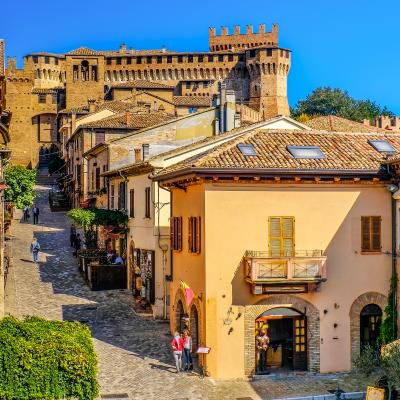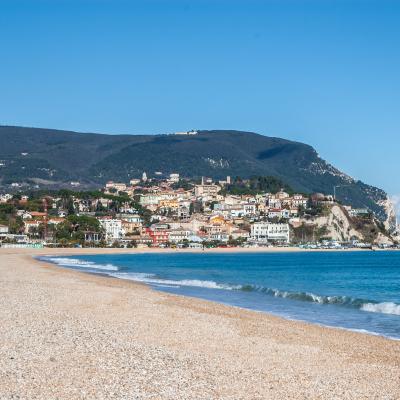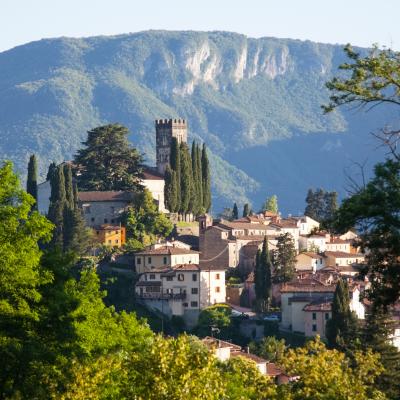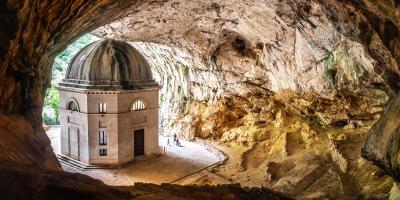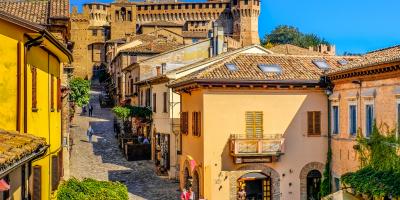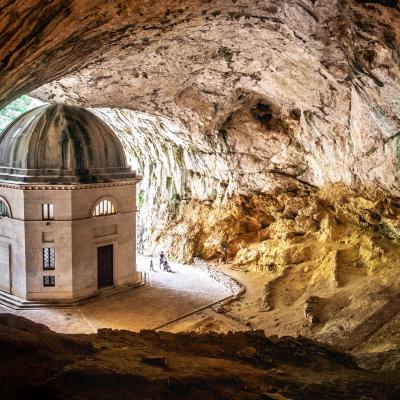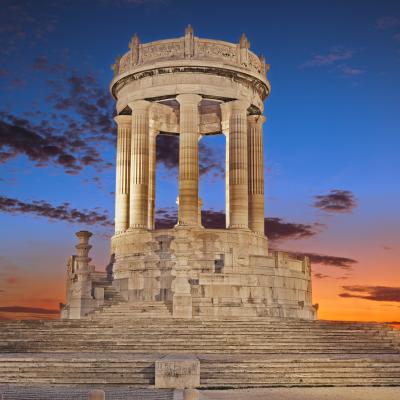Brands
Marches is located between the Umbro-Marchigiano Apennines and the Adriatic Sea, the region has mainly mountainous and hilly terrain while the coastline stretches along the Adriatic Sea for as much as 180 km.
The region has a booming tourist flow especially for its seaside resorts such as Pesaro, Senigallia, Porto San Giorgio and San Benedetto del Tronto, as well as cities of historical and artistic interest such as Urbino, Macerata and Fermo. Worth visiting are the Ducal Palace in Urbino, the Sferisterio in Macerata, and the Cathedral in Ancona. In the Marche region is the largest karst complex in Italy: the Frasassi Caves in Genga where there is a visitable path of about 1.5 km.
Not to be missed are Recanati, where poet Giacomo Leopardi was born, and the Holy House of Loreto, a destination for religious pilgrimages.
Ancient port hub, known as the "gateway to the Orient," Ancona is divided into two parts: the old town on Mount Guasco and the modern part on the coast. Among the main monuments we have the Cathedral of San Ciriaco, the National Archaeological Museum of Le Marche, the Trajan Arch and the Mole Vanvitelliana. Urbino's historic center and its Ducal Palace are included in the UNESCO list as an architectural and artistic example of the Italian Renaissance. Stop also in Gradara, the place where according to tradition Paolo and Francesca kissed, as narrated by Dante in the fifth canto of the Inferno. Ascoli Piceno, on the other hand, represents one of Italy's monumental cities, with its medieval historic center and Piazza del Popolo. Marche tourism are the ideal destination for those who love the sea: the coastline stretches 180 km and alternates between small fishing villages and seaside resorts. Renowned for their long stretches of fine, golden sand and crystal-clear water, Senigallia, Gabicce, Pesaro and San Benedetto del Tronto are the ideal destination for those in the mood for relaxation.
The city of Urbino is a beautiful example of Renaissance town planning; it was the possession of the Montefeltro family of Carpegna until 1626 when it was ceded to Urban VIII. The Ducal Palace of Urbino is a beautiful complex that was built starting in 1444 and later transformed by Luciano Laurana between 1465 and 1472, later worked on by Francesco di Giorgio Martini and Genga.
The courtyard of honor leads to the Marche National Gallery, which is one of the most important in the region. Inside are important paintings including the Portrait of a Gentlewoman also known as the mute work by Raphael; the Miracle of the Host by Paolo Uccello;the Flagellation and the Madonna of Senigallia by Piero della Francesca; the famous Ideal City; and a banner by Titian. In the halls of the palace it is possible to admire beautiful fireplaces as well as some Renaissance furniture. The gallery is spread over two floors while from the courtyard of honor you can access the basement in which the ancient kitchens, stables and cellars are located. Still worth visiting in Urbino is the Duomo, which was built in the 18th century by Valadier on a pre-existing 15th-century church. Inside are a number of paintings that are preserved in the chapels to the right and left of the high altar. Attached to the church is a museum that preserves ancient sacred furnishings. In Urbino it is possible to visit Raphael's birthplace, which contains a fresco inside depicting the Madonna and Child and Mosse saved from the waters attributed to the painter. As you leave the city, crossing the ancient 16th-century walls that still surround it, you can reach the Albornoz fortress.
Parks
The naturalistic heritage of the Marche region consists of two national parks: that of Monti Sibillini and Gran Sasso and that of Monti della Laga; four regional parks the Park of Monte Conero, Sasso Simone and Simoncello, the Park of Monte San Bartolo and Gola della Rossa e di Frasassi. There are also six nature reserves in the Marche region: Abbadia di Fiastra, Montagna di Torricchio, Ripa Bianca, Sentina, Gola del Furlo and Monte San Vicino and Monte Canfaito.
Terme
Numerous are the thermal resorts in the Marche region, starting from the north we point out in the province of Pesaro and Urbino the Terme di Monte Grimano, the Pitinum Thermae in Macerata Feltria, the Terme di Raffaello in Petriano and the Terme di Carignano in Fano. In the province of Ancona we find the Terme dell'Aspio in Camerano and the Terme San Vittore in Genga. In the province of Macerata, the Terme Santa Lucia in Tolentino and the Terme di Sarnano. Still going downhill, in the province of Fermo, there are the Terme di Palme in Torre di Palme while in the province of Ascoli Piceno are the Terme di Acquasanta.
Sea
The Marche region offers a long coastline that is characterized by beautiful beaches of golden sand, pebbles or rock, picturesque bays and marinas facing the Adriatic Sea. The sea in the Marches is rich in varied fish fauna; the Conero area with its beautiful views made up of cliffs and caves is protected as a Regional Park, here the wild headlands, picturesque coves and the splendid Portonovo Bay offer a wonderful spectacle. The northern coast of Marche is called the Riviera delle Colline and is characterized by very picturesque headlands and coves, here the scenic coastal road passes through picturesque fishing villages and theRegional Park of Monte San Bartolo, leads all the way to the towns of Fano and Marotta di Mondolfo. Very beautiful is the resort of Senigallia with its "velvet beach." Further south begins one of the most spectacular stretches of coastline on the Adriatic coast, the Riviera del Conero, here the coastline alternates between rocky cliffs and small, picturesque beaches. Very beautiful is the Bay of Portonovo , the charming resort of Sirolo overlooking the sea and Numana with its small port. Continuing south, the coast is characterized by flat beaches with the localities of Porto Sant'Elpidio, Porto San Giorgio and Lido di Fermo until reaching Pedaso. From here begins the Riviera delle Palme, a coastal area known for its wide beaches, green palm trees, oleanders and pine forests and with renowned seaside resorts such as Cupra Marittima, Grottammare and San Benedetto del Tronto.
Mountain
The Marche region has mountain ranges where enthusiasts can plan their vacations for sports and fun. In the winter season, you can enjoy downhill skiing or skiing on slopes of varying difficulty on the lifts at Sassotetto, Pintura, Frontignano and Monte Prata.
The Marche is a unique region, especially when it comes to nature. In fact, they are home to numerous national and regional parks (the Parks of the Sibillini Mountains and Monti della Laga) and fascinating WWF oases. The mountains of Le Marche and their streams provide a wonderful opportunity for winter sports, as well as canoeing, kayaking, rafting, free-flying and canyoning. However, the Marche's nature also offers ample room for cycling, golf, horseback riding, or-descending to the coast-sailing. The Conero Riviera offers evocative scenery and still wild patches, sometimes reachable only by sea or among paths cut out in the green Mediterranean scrub. Not to be missed are the Frasassi Caves, visited from all over Europe and of great interest, some of which have been inhabited since prehistoric times.
What to eat
The incredible cuisine of the Marche region offers its visitors a wide selection of dishes ranging from the delicious fish of the Adriatic to tasty mountain dishes, making for an unbeatable combination of sea and mountains. Mushroom sauces are very popular, even in combination with truffles, which are produced year-round. Particularly original and tasty is the preparation of pasta with pit cheese and mushroom sauce, especially maccheroncini di Campofilone. Traditional is vincisgrassi, lasagna prepared with pork meat, sausage, chicken livers and cinnamon. Passatelli alla marinara (egg pasta made with breadcrumbs, lemon, nutmeg, and Parmesan cheese, dressed with a delicious fish sauce) and brodetto all'anconetana (one of Italy's most renowned comics), are part of the seafood first courses.
Among the main courses, rabbit in porchetta, ncip nciap (a kind of pan-fried chicken all'arrabbiata), stuffed leg of lamb, and stuffed guinea fowl with chestnuts and mushrooms are absolutely not to be missed. As for fish dishes, try: stockfish prepared all'anconetana, perch fritters, sardine pie and mullet with prosciutto. One cannot forget the highly celebrated olive ascolane, a delicacy made from olives stuffed with pork, chicken, beef and livers, fried with egg and cheese and served with lemon and nutmeg. Noteworthy are Talamello pecorino cheese, wrapped in walnut leaves and aged in tuff caves, hams, lonzini and coppa di testa. Desserts include cavallucci (puff pastry treats with walnuts, almonds and raisins), frustingo (made with dried fruit) and chestnut ravioli. As for the enology of Marche tourism, the quality of the wines was already known to the ancient Romans: the Vernaccia di Serrapetrona DOCG, the Conero DOCG, the Rosso Piceno and the white Falerio dei Colli Ascolani.
